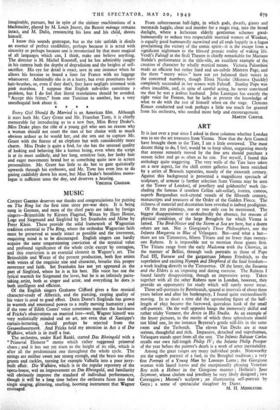ART
IT is just over a year since I asked in these columns whether London was to see the art treasures from Vienna. Now that the Arts Council have brought them to the Tate, I am a little overawed. The most decent thing to do, I feel, would be to keep silent, suggesting merely that anyone remotely moved by the fine arts should purchase a season ticket and go as often as he can. For myself, I found this anthology quite staggering. The very walls of the Tate have taken on a new aspect, for the chill centre galleries have been enriched by a series of Brussels tapestries, mostly of the sixteenth century. Against this background is presented a magnificent spectacle of sculpture, of armour (a further selection from Vienna may be seen at the Tower of London), of jewellery and goldsmiths' work (in- cluding the famous if tasteless Cellini salt-cellar), ivories, cameos, superb Burgundian rock-crystal vessels of the fifteenth century, manuscripts and treasures of the Order of the Golden Fleece. The richness of material and decoration here revealed is indeed prodigious. Of the 200 paintings, one or two only can be mentioned. The biggest disappointment is undoubtedly the absence, for reasons of physical condition, of the large Breughels for which Vienna is famed. The Bird-Nester and the Storm at Sea are here, but a dozen others are not. Nor is Giorgione's Three Philosophers, nor the Infanta Margareta in Blue of Velasquez. But—and what a but— there are ten Tintorettos, fifteen Titians and no fewer than twenty- one Rubens. It is impossible not to mention these giants first. The Titians range from the early Madonna with the Cherries, in the manner of Bellini, through such portraits as those of Pope Paul III, Farnese and the gargantuan Johann Friedrich, to the superlative and exciting Nymph and Shepherd of the final freedom— a work leading directly to the Tintorettos. Of the latter, the Susanna and the Elders is an imposing and daring exercise. The Rubens I found faintly disappointing, though an impressive array. Taken together with all the other Rubens now in London, however, they provide an opportunity for study which will surely never recur.
Three self-portraits by Rembrandt, spaced at intervals of about three years before and after his bankruptcy, I found quite extraordinarily moving. In so short a time did the upstanding figure of the half- length of 1652 become the furrowed, querulous husk of the small self-portrait. On the wall opposite hangs the immensely skilful and rather tricky Vermeer, the Artist in His Studio. As an example of the lesser pictures, to the merits of which these splendours should not blind one, let me instance Beyeren's gentle still-life in the same room and the Terborch. The eleven Van Dycks are at once serious, thoughtful and rich. Impassive, detached and superhuman, Velasquez stands apart from all the rest. The Infante Baltasar Carlos recalls our own full-length Philip IV; the Infante Philip Prosper of the year before the painter's death is a work of utter inevitability.
Among the great ranges are many individual peaks. Noteworthy are the superb portrait of a fool, in the Breughel tradition ; a very fine Portrait of a Young Man by Lorenzo Lotto ; the Giorgione woman with laurel leaves and the exceptionally pleasing Venetian Boy with a Helmet in the Giorgione manner ; Holbein's Jane Seymour, whose clothes and jewellery he very likely designed ; two Correggios ; Moroni's sculptor ; an illuminating self-portrait by Goya ; a scene of spectacular slaughter by Durer.
M. H. MIDDLETON.










































 Previous page
Previous page